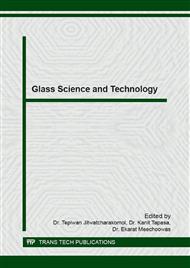[1]
E. M. Dianov, V. V. Dvoyrin, V. M. Mashinksy, V. M. Umnikov, M. V. Yashkov, A. N. Gur'yanov, CW bismuth fibre laser Quant. Elec. 35 (2005) 1083-1084.
DOI: 10.1070/qe2005v035n12abeh013092
Google Scholar
[2]
W. Xu, M. Peng, Z. Ma, G. Dong, J. Qiu, A new study on bismuth doped oxide glasses, Opt. Exp. 20 (2012) 15692-15702.
DOI: 10.1364/oe.20.015692
Google Scholar
[3]
X. Jiang, L. Su, P. Yu, H. Tang, X. Xu, L. Zheng, H. Li, J. Xu, Broadband photoluminescence of Bi2O3-GeO2 binary systems: glass, glass-ceramics and crystals, Laser Phys. 23 (2013) 105812-25.
DOI: 10.1088/1054-660x/23/10/105812
Google Scholar
[4]
Y. Fujimoto, M. Nakatsuka, Infrared luminescence from bismuth-doped silica glass, Jpn. J. Appl. Phys. 40 (2001) L279-L281.
DOI: 10.1143/jjap.40.l279
Google Scholar
[5]
H. T. Sun, J. Zhou, J. Qiu, Recent advances in bismuth activated photonic materials, Prog. Mat. Sci. 64 (2014) 1-72.
Google Scholar
[6]
V. O. Sokolov, V. G. Plotnichenko, E. M. Dianov, The origin of near-IR luminescence in bismuth-doped silica and germania glasses free of other dopants: First-principle study, Opt. Mat. Exp. 3 (2013) 1059-1074.
DOI: 10.1364/ome.3.001059
Google Scholar
[7]
V. O. Sokolov, V. G. Plotnichenko, E. M. Dianov, Origin of near-IR luminescence in Bi2O3-GeO2 and Bi2O3-SiO2 glasses: first-principle study, Opt. Mat. Exp. 5 (2015) 163-168.
DOI: 10.1364/ome.5.000163
Google Scholar
[8]
M. Y. Sharonov, A. B. Bykov, V. Petricevic, R. R. Alfano, Spectroscopic study of optical centers formed in Bi-, Pb-, Sn-, Te, and In-doped germanate glasses, Opt. Let. 33 (2008) 2131-2133.
DOI: 10.1364/ol.33.002131
Google Scholar
[9]
A. S. Zlenko, S. V. Firstov, K. E. Riumkin, V. F. Khopin, L. D. Iskhakova, S. L. Semjonov, I. A. Bufetov, E. M. Dianov, Optical properties of IR-emitting centres in Pb-doped silica fibres, Quantum Electronics 42 (2012) 310-314.
DOI: 10.1070/qe2012v042n04abeh014816
Google Scholar
[10]
B. I. Denker, B. I. Galagan, L. D. Iskhakova, S. E. Sverchkov, E. M. Dianov, Infrared luminescent properties of tin-silicate oxide glass, Appl. Phys. B 120 (2015) 13-15.
DOI: 10.1007/s00340-015-6146-5
Google Scholar
[11]
L. Skuja, Isoelectronic series of twofold coordinated Si, Ge, and Sn atoms in glassy SiO2: a luminescence study, J. Non-Cryst. Sol. 149 (1992) 77-95.
DOI: 10.1016/0022-3093(92)90056-p
Google Scholar
[12]
A. N. Trukhin, Localized states in wide-gap glasses. Comparison with relevant crystals, J. Non-Cryst. Sol. 189 (1995) 1-15.
DOI: 10.1016/0022-3093(95)00207-3
Google Scholar
[13]
M. Neff, V. Romano, W. Lüthy, Broadband fluorescence of Sb3+-doped silica fibres, Opt. Mat. 33 (2010) 1-3.
DOI: 10.1016/j.optmat.2010.07.003
Google Scholar
[14]
A. F. Zatsepin, I. S. Zhidkov, A. I. Kukharenko, D. A. Zatsepin, M. P. Andronov, S. O. Cholakh, An intrinsic luminescence in binary lead silicate glasses, Opt. Mat. 34 (2012) 807-811.
DOI: 10.1016/j.optmat.2011.11.012
Google Scholar
[15]
A. F. Zatsepin, H. -J. Fitting, E. A. Buntov, V. A. Pustovarov, B. Schmidt, Defects and localized states in silica layers implanted with lead ions, J. Lumin. 154 (2014) 425-429.
DOI: 10.1016/j.jlumin.2014.05.031
Google Scholar
[16]
S. E. Paje, M. A. García, M. A. Villegas, J. Llopis, Optical properties of silver ion-exchanged antimony doped glass, J. Non-Cryst. Sol. 278 (2000) 128-136.
DOI: 10.1016/s0022-3093(00)00332-x
Google Scholar
[17]
D. L. Griscom, E. J. Friebele, K. J. Long, J. W. Fleming, Fundamental defect centers in glass: Electron spin resonance and optical absorption studies of irradiated phosphorus‐doped silica glass and optical fibers, J. Appl. Phys. 54 (1983).
DOI: 10.1063/1.332591
Google Scholar


